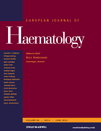Evaluation of the genetic basis of phenotypic heterogeneity in north Indian patients with Thalassemia major
Abstract
Objectives: To assess the molecular basis of phenotypic heterogeneity in north Indian patients with thalassemia major (TM). Methods: To determine the clinical severity, 130 patients of TM were studied for the age of first presentation and frequency of blood transfusion. The type of beta mutations, Xmn–1Gγ polymorphism and G6PD Mediterranean mutation was characterized. Analysis of the phenotypic presentation and the genotype was performed. Results: Majority (83.8%) presented before 1 year of age (mean 8.8 months). The caste distribution showed 41.6% were Aroras and 32.3% were migrants from Pakistan. IVS1-5(G→C) was commonest (32.7%) and the common five Indian mutations comprised of 88.4% of alleles. The mean age of presentation with IVS1-5(G→C), Fr 8/9, (+G) 619-bp del and IVS1-1(G→T) homozygosity was 4.3, 6, 3.4 and 9.1 months respectively. Xmn–1Gγ status showed −/− in 66.9%, +/− in 26.1% and +/+ in 6.9% patients. Xmn–1Gγ−/− presented before 1 year of age. The mean age of presentation with +/+ was 18.3 months. Six hemizygous boys and one heterozygous girl with G6PD Mediterranean were found (prevalence 5.3%). Eight patients could be reclassified as thalassemia intermedia on follow up. Conclusions: This study showed that majority of TM in north India present before 1 year of age and homozygous 619-bp deletion presents the earliest. The presence of Xmn-1Gγ polymorphism delays the presentation, is associated with the IVS 1-1 (G→T) and shows variable improvement with hydroxyurea therapy. Based on the results of genotyping, reevaluation of patients can improve the outcome in a few patients.




